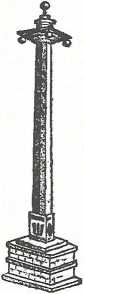Dipastambha
From Hindupedia, the Hindu Encyclopedia
By Swami Harshananda
Dipastambha literally means ‘the lamp-post’.
One of the constituents of a temple complex is the dipastambha or the lamppost. It is situated either in front of the balipīṭha[1] or outside the main gate. The top of this post has a bud-shaped chamber to receive the lamp.
During the days when electricity was not invented, a lamp-post served to give light in the public area to allow free movement.
References[edit]
- ↑ Balipīṭha is a pedestal of sacrificial offerings.
- The Concise Encyclopedia of Hinduism, Swami Harshananda, Ram Krishna Math, Bangalore

